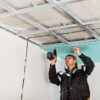Drywall is one of the most common building materials used in modern homes—and because of that, it’s also one of the most frequently damaged. From minor dings to serious holes, drywall damage happens. The good news? Most issues can be fixed with the right approach, tools, and timing. In this guide, we’ll cover the most common drywall repair problems and what to do about them, whether you’re a DIYer or someone who prefers to leave it to the pros.
Signs That Your Drywall Needs Repair
Knowing when to act is half the battle. Keep an eye out for these common indicators that your drywall needs attention:
– Visible cracks running along seams or corners
– Small to medium holes caused by impact or hardware removal
– Dents from furniture or door handles
– Water stains or sagging from leaks (especially on ceilings)
– Bubbling paint or texture that indicates underlying damage
These signs suggest it’s time for a quick wall repair—or in some cases, a full section replacement to maintain your home’s structural integrity and aesthetic.
How to Fix Minor Drywall Damage Yourself
Not all drywall problems require a professional. If the damage is small, these steps can help you handle it yourself:
Small Hole Repairs:
– Clean the area
– Apply spackle or lightweight joint compound
– Smooth it with a putty knife
– Let it dry completely, then sand and paint
Crack Prevention:
– Use fiberglass mesh tape over the crack
– Cover with a thin layer of joint compound
– Sand after drying, and reapply if necessary for a flush finish
These methods work well for basic drywall patch jobs and help prevent further wall damage.
When to Call a Professional for Drywall Repair
Some drywall damage goes beyond what a weekend repair kit can handle. Here’s when it’s best to bring in professional drywall repair services:
– Large holes or structural damage to framing
– Water damage affecting ceiling sections
– Signs of mold or rot behind the drywall
– Consistent cracking even after previous fixes
– Projects requiring plaster wall fixes or texture matching
In these cases, calling a pro ensures the problem is addressed safely and completely, while preserving the value and safety of your property.
The Best Materials for Drywall Repair
A solid repair starts with the right materials. Here’s what you need to know:
Joint Compound vs. Spackle:
– Use spackle for small nail holes or minor dents
– Opt for joint compound when taping seams, repairing cracks, or patching larger holes
Sanding Techniques:
– Use a sanding sponge or fine-grit sandpaper
– Sand between coats for a smooth, even surface
– Avoid over-sanding, which can thin the patch and create more work
Matching the repair to the surrounding wall texture is often the trickiest part—especially with older homes. This is where expert services like texture matching and interior wall restoration come in handy.
Cost-Effective Ways to Repair and Maintain Drywall
Maintaining your walls doesn’t have to be expensive. Here are some smart strategies to stretch your budget:
– Catch small issues early before they become costly repairs
– Use repair kits for basic fixes to avoid labor costs
– Repaint patched areas to blend the finish and add protection
– Regular home maintenance helps identify issues before they spread
– Hire pros strategically—call for ceiling repair or deep crack sealing, but DIY the small stuff
By combining smart DIY home repairs with targeted professional help, you’ll maintain your drywall’s integrity and appearance without overspending.
Conclusion
Drywall damage is nearly inevitable in any home—but it doesn’t have to become a major issue. From small dings to deeper repairs, knowing when and how to act can save you money, time, and stress. If you’re dealing with stubborn cracks, water damage, or a ceiling that needs serious attention, professional drywall repair is the best route.
Want it done right the first time? Reach out for expert support with everything from wall repair to interior wall restoration, and give your space the long-lasting finish it deserves.







0 Comments